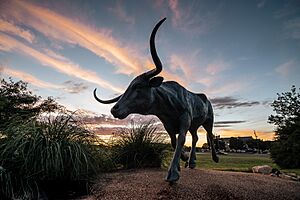National Ranching Heritage Center facts for kids

The National Ranching Heritage Center is a special museum in Lubbock, Texas. It's located on the Texas Tech University campus. This museum helps us remember and celebrate the history of ranching in the United States.
It was started in 1971 and covers 27 acres. The center has many real ranch buildings from the 1780s to the 1950s. These buildings show how ranching grew in North America.
Visitors can learn about the ranching industry through different exhibits. These exhibits display old tools, items, and artifacts. The center also offers educational programs and events. These activities teach about the cowboy way of life. They also show how ranching helped shape the American West. Ranching still plays an important part in our lives today. The National Ranching Heritage Center helps keep the rich history of ranching alive. It also teaches future generations about this important part of our nation's Western heritage.
In 2024, the NRHC announced a new art institute. It will be called the Red Steagall Institute of Western Art. It is named after Red Steagall, who is an actor, musician, and poet from Gainesville, Texas. Steagall is known for his American Western and country music. This new institute will have interactive classes and displays. People can learn all about Western culture there. The Texas Tech System Board of Regents approved this $28 million expansion in May 2024. Jim Bret Campbell, who is the executive director of the NRHC, said that this expansion happened because Steagall and his wife wanted to donate his collection. This collection includes Western songs, poetry, and recordings from his radio and television shows.
History of Ranching
On January 22, 2019, the Heritage Center opened an exhibit. This exhibit shows how important different types of cattle were to the southwestern United States. The first cattle, the exhibit explains, were Andalusian cows. They were brought to America by Christopher Columbus on his second trip. Later, other breeds like Hereford, Angus, and the Texas Longhorn arrived. These cattle breeds greatly influenced the future of the American West.
Gallery
-
The Barton House, an example of Queen Anne style architecture, was moved to the Heritage Center from Hale County. It is named for Texas pioneer Joseph J. Barton.
-
U Lazy S Carriage House, owned by John B. Slaughter, was moved from Post to the NRHC.
-
Hedwig's Hill Dogtrot House (1855) is essentially two log cabins under a common roof relocated from Mason County
-
The 6666 barn stood near the home of rancher Samuel Burk Burnett in Guthrie until it was removed to the NRHC.
-
The Jowell House (1872-1873) from Palo Pinto County is a fortress style residence, with an outside ladder to the second floor.
-
Because children frequently died young in the American West, the heritage center relocated this Jowell Cemetery (1876-1889) from Palo Pinto County.
-
Atchison, Topeka and Santa Fe Railroad at the Ropes Depot
-
This half-dugout (1888) in Dickens County was removed from the Matador Ranch to the NRHC.
-
Waggoner Ranch commissary (1870s), relocated to the NRHC from Wichita County
-
Box and strip house (1903, 1907), with dual entrances but uninsulated, was relocated to the NRHC from Martin County.
-
Pioneer mail station (1875) relocated from Knox County
-
Starmill windmill at NRHC
-
The Harrell House, named for sisters Fay and Myrtle Harrell of Scurry County, was built in phases between 1885 and 1917.
-
Restored Pitchfork Ranch cookhouse from Dickens County at NRHC
-
The Los Corralitos (meaning "Little Corrals") Building was relocated to the Heritage Center from Zapata County in South Texas
-
Replica of Charles Weldon "Tooter" Cannon (1915-1997) Saddle Shop at Heritage Center
See also

























